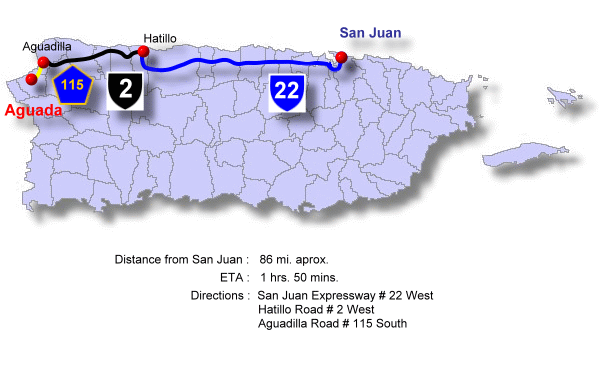
Aguada, Puerto Rico
Sotomayor’s Villa

Aguada (ah-GWAH-dah) is known as “El Pueblo Playero” (Beach Town), “La Ciudad del Vaticano”, “Sotomayor’s Villa” and “Villa de San Francisco de Asís”, this last name in reference to the town’s patron saint. There’s also a say, “Por Aguada fue” which means that Aguada was the first place where Christopher Columbus landed.
Aguada is located on the island’s western region. On the north, it borders the Atlantic ocean and the municipality of Aguadilla; on the south, are the municipalities of Rincón and Añasco; on the east are Aguadilla and Moca, and on the west is Rincón.
Geographically, it belongs to the zone known western coastal plains, where the soil is alluvial and very fertile. On Aguada’s coast, the peak called “Boquerón” protrudes; it is located in the Carrizal area. In addition, there are deposits of manganese and small amounts of copper in this municipality.
This municipality’s economy, until some decades ago, was mainly based on growing and processing sugarcane. Besides plantation estates, other economic activities also existed; such as: livestock farming and lumber production. Central Coloso operated as a sugar refinery from 1875 to 2000. Other economic activities in town were cattle farming and lumber production. Today, Aguada’s economy is based on the development of small businesses and a limited number of factories of foreign capital.
Foundation:
Aguada, a municipality on Puerto Rico’s west coast that was founded in 1692, was known at the time of the Spanish conquest as a water supply point for ships that traveled between America and Europe; that is where its name comes from: “aguada” means watered down. However, this town is also known as “El Pueblo Playero” (Beach Town), “La Ciudad del Vaticano”, “Villa Sotomayor”, and “Villa de San Francisco de Asís”, this last name in reference to the town’s patron saint. There’s a say “Por Aguada fue” meaning that Aguada was the first place where Christopher Columbus landed.
About three hundred years ago on September 17, 1692, King Carlos II of Spain issued a Royal Certificate causing five small villages to ascend to the category of Collective Parish, each with a First Lieutenant. These villages were: Aguada, Ponce, Arecibo, Coamo and Loíza. The honor of the position of First Lieutenant for Aguada was given to Mr. Juan López de Segura. The historical data indicates that on September 17, 2002, Aguada celebrated 310 years as a Parish.
Nevertheless, understand that this was not the birth of Aguada. Aguada was founded in 1510, when Don Cristóbal de Sotomayor, lieutenant of Don Juan Ponce de Leon, and by orders of Don Juan Ponce de Leon, founded the first town on the site of Aguada with the name of Villa de Sotomayor. The date of this occurrence makes Aguada the second town after Caparra.
In the year, 1511, King Fernando arranged for the Island of Puerto Rico to errect a monastery, which gave origin to the Hermitage del Pinar. Then the Villa de Sotomayor became San Francisco de Asis of Aguada when the Franciscan friars came to found this monastery. It was completed in 1516. Perhaps thirteen years later, in 1529, the Indians killed the friars and burned the hermitage, the friar’s blood becoming the first martyr blood of Puerto Rico and of all the New World.
Three years before the event mentioned in the previous paragraph, in 1526, King Carlos I founded by Royal Certificate the permanent town of Aguada. It is not the aguadeños, but history, that gives Aguada the honor of being the second town of Puerto Rico, (1510) and Craddle of Christianity in the New World, (1529). All aguadeños feel really proud of this fact!
*Source: Translated from an informative pamphlet from the Office for Cultural Subjects and Relations published by the Municipality of Aguada.
Location:
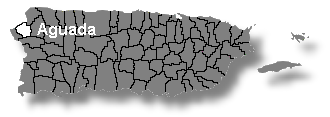 The municipality of Aguada is bordered by: the Atlantic Ocean and the municipality of Aguadilla to the north; and the municipalities of Rincón and Añasco to the south, Aguadilla and Moca to the east, and Rincón to the west.
The municipality of Aguada is bordered by: the Atlantic Ocean and the municipality of Aguadilla to the north; and the municipalities of Rincón and Añasco to the south, Aguadilla and Moca to the east, and Rincón to the west.
Area:
78 sq km / 30.0 sq mi
Population:
42,042
Population Density:
539 per sq km / 1,401.4 per sq mi
People are known as:
Aguadeños
Wards: Aguada, Puerto Rico
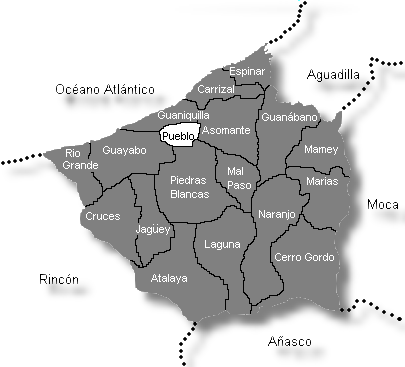
| Censo 2000: Population by Wards – Aguada | Habitants |
|---|---|
| Aguada Town | 1,755 |
| Asomante | 3,268 |
| Atalaya | 2,767 |
| Carrizal | 1,063 |
| Cerro Gordo | 2,930 |
| Cruces | 1,655 |
| Espinar | 1,569 |
| Guanábano | 902 |
| Guaniquilla | 2,846 |
| Guayabo | 2,961 |
| Jagüey | 1,926 |
| Lagunas | 3,315 |
| Mal Paso | 2,614 |
| Mamey | 2,170 |
| Marías | 1,786 |
| Naranjo | 3,724 |
| Piedras Blancas | 3,542 |
| Río Grande | 1,249 |
| Total | 42,042 |
Source: Censo 2000
Patron:
San Francisco de Asís
San Francisco de Asís Parish
Apartado 608
Aguada, P.R. 00602
Tel. (787) 868-2630
Mass Schedule:
Daily: 6:30am & 7:15am
Saturday: 7:00am, 5:00am & 7:30pm
Sunday: 6:30am, 8:00am, 9:30am, l0:30am & 8:00pm

Topography:
This region is part of what is known as the Costal Valley of the West. It has some mountains, among them, part of the San Francisco mountain, which cradles the Central Mountain Range of the island.
Hydrography:
The Rio Culebrina, 25 miles in length, and the Rios Ingenio, Madre Vieja, Guayabo, Grande, and other smaller bodies comprise the hydrographic system.
Economy:
Agriculture (sugar cane and cattle) and manufacturing.
Average Salary:
$266.99 weekly (1998)
Flag:
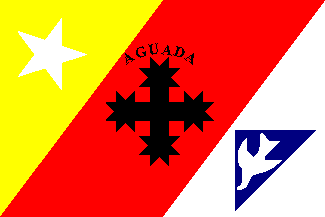 The flag of the Villa de San Francisco de Asís de la Aguada is a tricolor one: white, red and yellow (in no specific order). This flag was designed by Pedro Vélez Adrover. White stands for human purity and the quietness of the crystal waters of the Culebrinas River and the Columbine Wells. Over the white background is a blue triangle with a white dove in the center, a symbol of peace that unites all people in a fraternal hug.
The flag of the Villa de San Francisco de Asís de la Aguada is a tricolor one: white, red and yellow (in no specific order). This flag was designed by Pedro Vélez Adrover. White stands for human purity and the quietness of the crystal waters of the Culebrinas River and the Columbine Wells. Over the white background is a blue triangle with a white dove in the center, a symbol of peace that unites all people in a fraternal hug.
Red stands for the martyrdom of the Franciscan friars of El Espinal. Above the red background arises a cross as the victorious standard of the birth of Christianity in Puerto Rico, and surrounding the cross the name of the city of Aguada. Yellow stands for its inhabitants’ happiness and hospitality, and over the yellow center a star, as a symbol of the people’s hope for attaining greater development and progress.
Coat Of Arms:
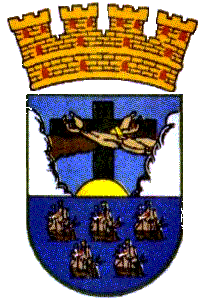 The Coat of Arms of Aguada is the seal that the Municipal Government officially uses. It was given to the “Villa de San Francisco de Asís de la Aguada” by King Charles III’s Royal Bill of Grace of January 14, 1778. The Coat of Arms recognized the personality of the Village (Villa) as part of the Island of San Juan Bautista de Puerto Rico. It carries the symbols of history, religion and culture. The cross, with the interlaced arms of the Redeemer and our Father Saint Francis, signifies the badge of the Order of Frays of San Francisco, which means: “Peace and fraternal hug between man and the Redeemer”.
The Coat of Arms of Aguada is the seal that the Municipal Government officially uses. It was given to the “Villa de San Francisco de Asís de la Aguada” by King Charles III’s Royal Bill of Grace of January 14, 1778. The Coat of Arms recognized the personality of the Village (Villa) as part of the Island of San Juan Bautista de Puerto Rico. It carries the symbols of history, religion and culture. The cross, with the interlaced arms of the Redeemer and our Father Saint Francis, signifies the badge of the Order of Frays of San Francisco, which means: “Peace and fraternal hug between man and the Redeemer”.
The sun below the cross symbolizes the light that brightens the world. He who believes in Light and in Truth shall not be blind forever. The lower part of the shield consists of five Columbine ships that symbolize the second voyage of Christopher Columbus, who arrived to our island on November 19, 1493, by the “Guaniquilla” coast, where he calmed his thirst in the Aguada wells. (Very contested, but it is probably the most plausible site of the actual landing). The crown in the upper part of the shield signifies the title “Muy Leal Villa” (very loyal village), that was given to this town by King Charles III in the Royal Bill of Grace of January 14, 1778. The official colors of the shield are: red, standing for the fraternal love that kindles all Aguada; gold, standing for the Spanish royalty in Puerto Rico; green, standing for our land’s hope and fertility; black, standing for the beam that redeemed the world; blue, standing for the sky and the kingship of the Creator; white, standing for the Redeemer’s purity and the purity of our people toward the cultural patrimony.
Places To Visit:
- Central Coloso
- Ermita Espinar
- Iglesia San Francisco de Asís
- La Cruz de Culebrinas
- Museo de Aguada
Events:
- Artisan festival– October
- Festival of the Discovery – November
- Patron Saint Festival – October
Distinguished Citizens:
- Juan Bautista Arrillaga Roqué – Journalist, essayist, playwright, abolitionist, and pharmacist. Autonomist who told the Spanish Government of the repressive politics on the island at the end of the 1880’s. Director of El Aguila, daily newspaper in Puerto Rico. He published his book Memorias de Antaño, the comedy Tierra enferma, and the drama Los bribones.
- Zoilo Cajigas Sotomayor – Artist dedicated to popular imagery or carving saints. An elementary school on the urban area of the municipality (Montemar) has his name.
- Mabel Vélez Acevedo – First woman mayor of Aguada. She served from 1972 to 1976.
Public Schools sorted by educational levels
Mayagüez Region
District: Aguada
| Name | Level | Telephone | Address |
| Elementary | |||
| ANSELMO VILLARRUBIA | K-6 | (787) 868-8735 | PO Box 1726, P.R. 00602-1726 |
| ANTONIO SÁNCHEZ RUIZ | K-6 | (787) 868-5150 | PO Box 519, P.R. 00602-0519 |
| EUGENIO GONZÁLEZ GONZÁLEZ | K-6 | (787) 868-6100 | PO Box 865, P.R. 00602-0000 |
| GREGORIO RODRÍGUEZ ORAMA | K-6 | (787) 252-2594 | PO Box 1442, P.R. 00602-0000 |
| JOSÉ GONZÁLEZ RUIZ | K-6 | (787) 868-5740 | PO Box 7000 Suite 4, P.R. 00602-0000 |
| JUAN LINO SANTIAGO | K-6 | (787) 868-5600 | PO Box 9000 Suite 660, P.R. 00602-0000 |
| LYDIA MELÉNDEZ | K-6-EE | (787) 868-3850 | PO Box 519, P.R. 00602-0000 |
| MANUEL MORALES FELICIANO | K-6 | (787) 868-0608 | PO Box 519, P.R. 00602-0519 |
| MARIA L. JIMÉNEZ LÓPEZ | K-6-EE | (787) 252-2598 | MSC 813 PO Box 5000, P.R. 00602-0000 |
| PADRE PABLO GUTIÉRREZ | K-6 | (787) 868-5140 | PO Box 865, P.R. 00602-0000 |
| PETRA VALLE VILLANUEVA | K-6 | (787) 868-5000 | P O Box 519, P.R. 00602-0000 |
| ZOILO CAJIGAS SOTOMAYOR | K-6-EE | (787) 868-8105 | PO Box 1242, P.R. 00602-1242 |
| Intermediate | |||
| CENTRO VOCACIONAL ESPECIAL | EE | (787) 868-3245 | PO Box 519, P.R. 00602-0519 |
| INTERMEDIA NUEVA | 7-9 | (787) 868-2260 | Apartado 547, P.R. 00602-0000 |
| Secondary | |||
| ELADIO TIRADO LÓPEZ | 7-12 | (787) 868-2161 | Box 9000 Suite 671, P.R. 00602-0000 |
| Jr. High | |||
| AQUILINO CABAN | PK-8-EE | (787) 252-4699 | PO Box 9000 Suite 673, P.R. 00602-0000 |
| SU EPIFANIO ESTRADA | K-9-EE | (787) 868-2670 | PO Box 1589, P.R. 00602-0000 |
| SU JUAN B. SOTO | K-8 | (787) 868-4470 | PO Box 1097, P.R. 00602-0000 |
| SU MARTÍN HERNÁNDEZ | K-9 | (787) 891-0914 | PO Box 519, P.R. 00602-0000 |
| High School | |||
| ARSENIO MARTÍNEZ | 10 | (787) 868-0299 | PO Box 519, P.R. 00602-0000 |
| DR. CARLOS GONZÁLEZ | 10-12 | (787) 868-3280 | PO Box 1516, P.R. 00602-0000 |
Hymn:
By Rolando Acevedo Lorenzo
Muchos siglos han pasado… ¡Por Aguada fue!
Terminando el Siglo Quince, en el noventa y tres.
¡Aquí fue! ¡Sí señor! ¡Aquí fue!
¡Noviembre diecinueve, por Aguada fue!
Por tus playas entró la Luz de Cristo Redentor.
Por tus playas llegó la Lengua del Conquistador.
Con la Cruz, del Señor el Amor;
y con el Castellano el verbo ardiente y creador.
Tienes la Ermita de Espinar, donde a los Frailes se inmoló,
teniendo así el honor de ser, primeros Mártires de Dios.
¡Y aquí fue; y así fue que surgió
el Génesis Isleño; Villa de Sotomayor!
Aguadilla, San Sebastián, Moca y el pueblo de Rincón;
¡tus hijos son!; ¡tus hijos son!
Por eso en la historia serás faro de luz, piedra angular
y en este cielo de Borinquen, con luz propia brillarás.
¡Y en este cielo de Borinquen, con luz propia brillarás!

